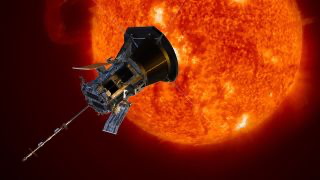Context: The Parker Solar Probe has traveled 6.1 million km from the Sun’s surface, marking the closest approach of any human-made object. At this distance, if the Earth and Sun were 1 meter apart, the probe would be just 4 cm from the Sun.

What is the Parker Solar Probe?
About
• Launched on August 12, 2018, as part of NASA’s “Living With a Star” program, this mission aims to study the Sun’s corona and solar winds.
• It is named after Eugene Parker, the first NASA mission to be named after a living researcher.
• Size: Similar to a small car.
• Instruments: The probe is equipped with four instruments designed to study electric and magnetic fields, plasma, and high-energy particles.
• It has completed 21 orbits around the Sun and uses Venus flybys to gradually move closer to the Sun.
How did it manage to come so close to the Sun?
• On December 24, 2024, the Parker Solar Probe reached 6.1 million km from the Sun’s surface, marking the closest approach by any human-made object.
Technologies:
• Heat Shield: A 4.5-inch carbon-composite shield withstands temperatures of up to 1,377°C while maintaining the instruments at a stable 29.4°C.
• Venus Flybys: Gravitational assists from Venus have gradually reduced the probe’s orbit.
• Speed: It travels at 6,92,000 km/h, making it the fastest human-made object.
Significance of the Mission
• Scientific Contributions: Offers valuable insights into why the Sun’s corona is significantly hotter than its surface and helps understand the origins of solar winds.
• Practical Implications: Enhances the ability to predict space weather events that can impact satellites, power grids, and communication systems on Earth.
• Technological Achievement: Showcases advanced spacecraft engineering capable of withstanding the extreme conditions near the Sun.

